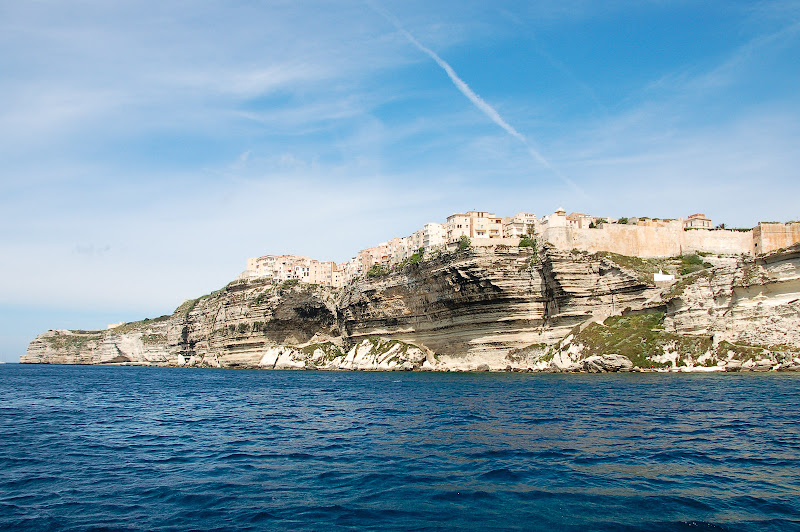Corsica: The South by Car
Following up on the previous post about hiking the Mare a Mare Sud, here's the chronology of events for the rest of the trip.
Thursday, May 7
We woke up slowly in the tent, did laundry, and made our way to Porto Vecchio. We saw the sea (thereby officially ending the hike) while we had lunch in the port.

The town is full of interesting old buildings, walls, and gates.



We decided it would be best to rent a car to be able to explore more of the island, as well as to have a place to lock up our stuff (since we were staying in campsites). The first thing we did with the car was to drive to an out of the way beach and lay out in the sun for a while.

The view out to sea was quite impressive:

While on the beach, we chose a restaurant from the guide book and drove out there. It's called Le Passe Temps (The Pass Time, obviously) and was really delicious. Esther had grilled pork and I had a pizza from their wood-fired oven. We were quite lucky because they had only opened for the season that night. It was clearly popular with the locals, the owners were a bit distracted as their friends kept pulling them aside to talk to them.
Friday, May 8
We drove around quite a bit, passing many of the towns that we crossed while hiking and seeing others that we couldn't quite get to. I've traced our route on the map below. Leaving from Porto Vecchio, we saw L'Ospedale, Zonza, Levie, Santa Lucia, Sartène, and finally Bonifacio.
View Drive 1 in a larger map
As one can imagine, there were plenty of wonderful sights. A sampling:


Sartène was particularly impressive with its narrow, convoluted streets and passageways.



We arrived in Bonifacio, our final destination, in the late evening. It is another impressive city as it's built onto the white cliffs that overlook the southern tip of the island.

The geology forms a nearly perfect natural harbor, in which a marina has been built which has become popular with mega-yachts. (Fun fact! The natural harbor of Bonifacio is believed to have been visited by Odysseus during his travels in The Odyssey, given how closely it matches the description.)


The city, like Sartène, also has beautiful, narrow streets, full of intriguing details.


Night fell, we had dinner on the port, and made our way back to the campsite, exhausted once again.

Saturday, May 9
On our last full day in Corsica, we started by walking out to the lighthouse outside of Bonifacio. The view was incredible.

Coming back in, we took a boat tour of the cliffs and the lagoons around Bonifacio.





We continued our explorations, making our way up to the archaeological site of Filitosa. The site has been inhabited for about 7,000 years by various tribes, one of which built many (rather phallic) statues which apparently depicted their enemies. It was impressive to be on such an old site.

Everything was old there, even the big olive tree in the center of these statues is thought to be 1,200 to 2,000 years old.

Finally, for our last dinner in Corsica, we decided to explore the small town of Campomoro. It required driving out on a harrowing road. You may have images of "dangerous road" in your mind; this must be the model. It was a strip of pavement about one and a third lanes wide, with no lane markings, no guardrails, and no shoulders stuck to the side of the cliff. Oncoming traffic (which there was thankfully very little) meant coming to a near stop and narrowly brushing by. To make matters worse, there were often cattle and sheep on the side or in the middle of the road. In short, quite an adventure.
View Untitled in a larger map
The effort however, was well worth the beach and the dinner. The beach was just about perfect and the dinner (at the nice hotel in town) was fantastic. Bonifacio-style eggplants (aubergines à la bonifacienne) may be the best food I've ever tasted.


We said goodbye to the sea and the mountains, and made our way back to the campsite. (Back along the same road, now in the dark.)
Sunday, May 10
We were supposed to get up and leave, but little did we know, Corsica had one last surprise for us.
We had some extra time so we decided to have a coffee up in the old city of Bonifacio. We went to the first, cheapest-looking place that we saw, ordered our coffee and croissants (it's still France, after all), made our way to the back of the cafe and were greeted with the following sight:

We had our coffee and croissants (technically, Esther had a pain au chocolat) overlooking both the sea and the cliffs. A wonderful surprise, and a wonderful end to a fantastic trip.




What kind of camera are you using? The pictures are gorgeous, but the saturated color really makes them. Looks like it was quite the trip! Life's hard, isn't it Kurt? Drowning in envy here.
ReplyDeleteI have the same question! Your photos are awesome. You have captured scenes in Corsica I haven't been to yet.
ReplyDeleteI meant to add, your photos of Bonifacio are incredible and that last shot... please do tell, where did you have that coffee and croissant? I imagine it's somewhere on the Haute Ville?
ReplyDeleteHey all, the camera is my trusty Nikon D50 with the 18-200 Nikkor lens. It's about all I'd ever need. I'm glad you liked the photos!
ReplyDeleteThe cafe at the end was indeed in the Haute Ville, though I can't remember exactly what it was called. From memory though, it must be somewhere near the marker on this map: http://maps.google.com/maps/ms?ie=UTF8&hl=en&msa=0&ll=41.386553,9.158177&spn=0.00299,0.006974&t=h&z=18&msid=104431679076304509055.00046cde2d948c3bf19f9
The outside was very nondescript, it just looked like a cheap cafe. It's definitely worth finding again!